Electromagnetic Interference Shielding Effectiveness of Pure SiC–Ti3SiC2 Composites Fabricated by Reactive Melt Infiltration
Abstract
1. Introduction
2. Experimental Procedure
2.1. Preparation of SiC–Ti3SiC2 Composites
2.2. Characterizations
3. Results and Discussions
4. Conclusions
Author Contributions
Funding
Institutional Review Board Statement
Informed Consent Statement
Data Availability Statement
Conflicts of Interest
References
- Yin, X.W.; Xue, Y.Y.; Zhang, L.T.; Cheng, L.F. Dielectric, electromagnetic absorption and interference shielding properties of pour yttria-stabilized zirconia/silicon carbide composites. Ceram. Int. 2012, 38, 2421–2422. [Google Scholar] [CrossRef]
- Chen, Y.; Zhang, H.B.; Yang, Y.; Wang, M.; Cao, A.; Yu, Z.Z. High-performance epoxy nanocomposites reinforced with three-dimensional carbon nanotube sponge for electromagnetic interference shielding. Adv. Funct. Mater. 2016, 26, 447–455. [Google Scholar] [CrossRef]
- Yin, X.W.; Cheng, L.F.; Zhang, L.T.; Travitzky, N.; Greil, P. Fibre-reinforced multifunctional SiC matrix composite materials. Int. Mater. Rev. 2017, 62, 117–172. [Google Scholar] [CrossRef]
- Li, S.G.; Tan, Y.Q.; Xue, J.X.; Liu, T.; Zhou, X.S.; Zhang, H.B. Electromagnetic interference shielding performance of nano-layered Ti3SiC2 ceramics at high-temperatures. Aip Adv. 2018, 8, 259–266. [Google Scholar] [CrossRef]
- Cai, Y.Z.; Wang, N.; Chen, L.F.; Yin, X.W. Electrical conductivity and electromagnetic shielding properties of Ti3SiC2/SiC functionally graded materials prepared by positioning impregnation. J. Eur. Ceram. Soc. 2019, 39, 3643–3650. [Google Scholar] [CrossRef]
- Yin, X.W.; Kong, L.; Zhang, L.T.; Cheng, L.F.; Travitzky, N.; Greil, P. Electromagnetic properties of Si–C–N based ceramics and composites. Int. Mater. Rev. 2014, 59, 326–355. [Google Scholar] [CrossRef]
- Fan, X.M.; Ma, Y.Z.; Dang, X.L.; Cai, Y.Z. Synthesis and Electromagnetic Interference Shielding Performance of Ti3SiC2-Based Ceramics Fabricated by Liquid Silicon Infiltration. Materials 2020, 13, 328. [Google Scholar] [CrossRef]
- Shi, S.; Zhang, L.; Li, J. Ti3SiC2 material: An application for electromagnetic interference shielding. Appl. Phys. Lett. 2008, 93, 172903. [Google Scholar] [CrossRef]
- Pan, L.M.; Song, K.; Gu, J.; Qiu, T.; Yang, J. Microstructure and Mechanical Properties of (TiB2 + SiC) Reinforced Ti3SiC2 Composites Synthesized by In Situ Hot Pressing. Int. J. Appl. Ceram. 2016, 13, 629–635. [Google Scholar] [CrossRef]
- Csáki, S.; Lukáč, F.; Veverka, J.; Chráska, T. Preparation of Ti3SiC2 MAX phase from Ti, TiC, and SiC by SPS. Ceram. Int. 2022, 48, 28391–28395. [Google Scholar] [CrossRef]
- Fan, X.M.; Yin, X.W.; Cai, Y.Z.; Zhang, L.T.; Cheng, L.F. Mechanical and Electromagnetic Interference Shielding Behavior of C/SiC Composite Containing Ti3SiC2. Adv. Eng. Mater. 2018, 20, 1700590. [Google Scholar] [CrossRef]
- Zhang, N.L.; Hou, B.Q.; Zhi, Q.; Zhang, M.J.; Yang, J.F.; Wang, B. Performance enhancement in RMI-fabricated SiC-Ti3SiC2 composites via microstructure optimization. J. Eur. Ceram. Soc. 2024, 44, 2903–2915. [Google Scholar] [CrossRef]
- Jung, Y.L.; Park, D.J.; Park, J.H.; Park, J.Y.; Kim, H.G.; Koo, Y.H. Effect of TiSi2/Ti3SiC2 matrix phases in a reaction-bonded SiC on mechanical and high-temperature oxidation properties. J. Eur. Ceram. Soc. 2016, 36, 1343–1348. [Google Scholar] [CrossRef]
- Zhang, Y.M.; Yuan, Z.Y.; Zhou, Y.F. Gel casting of silicon carbide ceramics using phenolic resin and furfuryl alcohol as the gel former. Ceram. Int. 2014, 40, 7873–7878. [Google Scholar] [CrossRef]
- Geetha, S.; Kumar, K.K.S.; Rao, C.R.K.; Vijayan, M.; Trivedi, D.C. EMI shielding: Methods and materials—A review. J. Appl. Polym. Sci. 2009, 112, 2073–2086. [Google Scholar] [CrossRef]
- Singh, A.P.; Gary, P.; Alam, F.; Singh, K.; Tandon, R.P. Phenolic resin-based composite sheets filled with mixtures of reduced graphene oxide, γ-Fe2O3 and carbon fibers for excellent electromagnetic interference shielding in the X-band. Mater. Carbon. 2012, 50, 3868–3875. [Google Scholar] [CrossRef]
- Chen, J.L.; Ye, F.; Cheng, L.F.; Yang, J.S.; Chen, X. Preparation and properties of Ti3SiC2 preform reinforced SiC ceramic matrix composites. J. Eur. Ceram. Soc. 2023, 43, 3146–3157. [Google Scholar] [CrossRef]
- Dong, N.; Chen, L.Q.; Yin, X.W.; Ma, X.K. Fabrication and electromagnetic interference shielding effectiveness of Ti3Si(Al)C2 modified Al2O3/SiC composites. Ceram. Int. 2016, 42, 9448–9454. [Google Scholar] [CrossRef]
- Song, R.G.; Si, Y.F.; Qian, W.; Zu, H.R.; Zhou, B.L. Investigation of MXene nanosheets based radio-frequency electronics by skin depth effect. Nano. Res. 2024, 17, 3061–3067. [Google Scholar] [CrossRef]
- Wang, G.H.; Liu, J.X.; Liu, X.C.; Li, M.H.; Liu, J.J.; Chai, N.; Xu, H.L. Oxidation-resistant vitamin C/MXene foam via surface hydrogen bonding for stable electromagnetic interference shielding in air ambient. Appl. Surf. Sci. 2023, 610, 3061–3067. [Google Scholar] [CrossRef]
- Han, T.; Luo, R.Y. Effect of carbon nanotubes on the electromagnetic shielding properties of SiCf/SiC composites. J. Alloys Compd. 2018, 745, 90–99. [Google Scholar] [CrossRef]
- Mei, H.; Hao, D.Y.; Xiao, S.S.; Ji, T.M.; Tang, J.; Chen, L.F. Improvement of the electromagnetic shielding properties of C/SiC composites by electrophoretic deposition of carbon nanotube on carbon fibers. Carbon 2016, 109, 149–153. [Google Scholar] [CrossRef]
- Chen, C.; Tan, Y.Q.; Han, X.C.; Heng, L.; Zeng, S.F.; Peng, S.M.; Zhang, H.B. Enhanced electromagnetic interference shielding properties of silicon carbide composites with aligned graphene nanoplatelets. J. Eur. Ceram. Soc. 2018, 38, 5615–5619. [Google Scholar] [CrossRef]
- Liu, X.L.; Yin, X.W.; Duan, W.Y.; Ye, F.; Li, X.L. Electromagnetic interference shielding properties of polymer derived SiC-Si3N4composite ceramics. J. Mater. Sci. Technol. 2019, 35, 2832–2839. [Google Scholar] [CrossRef]
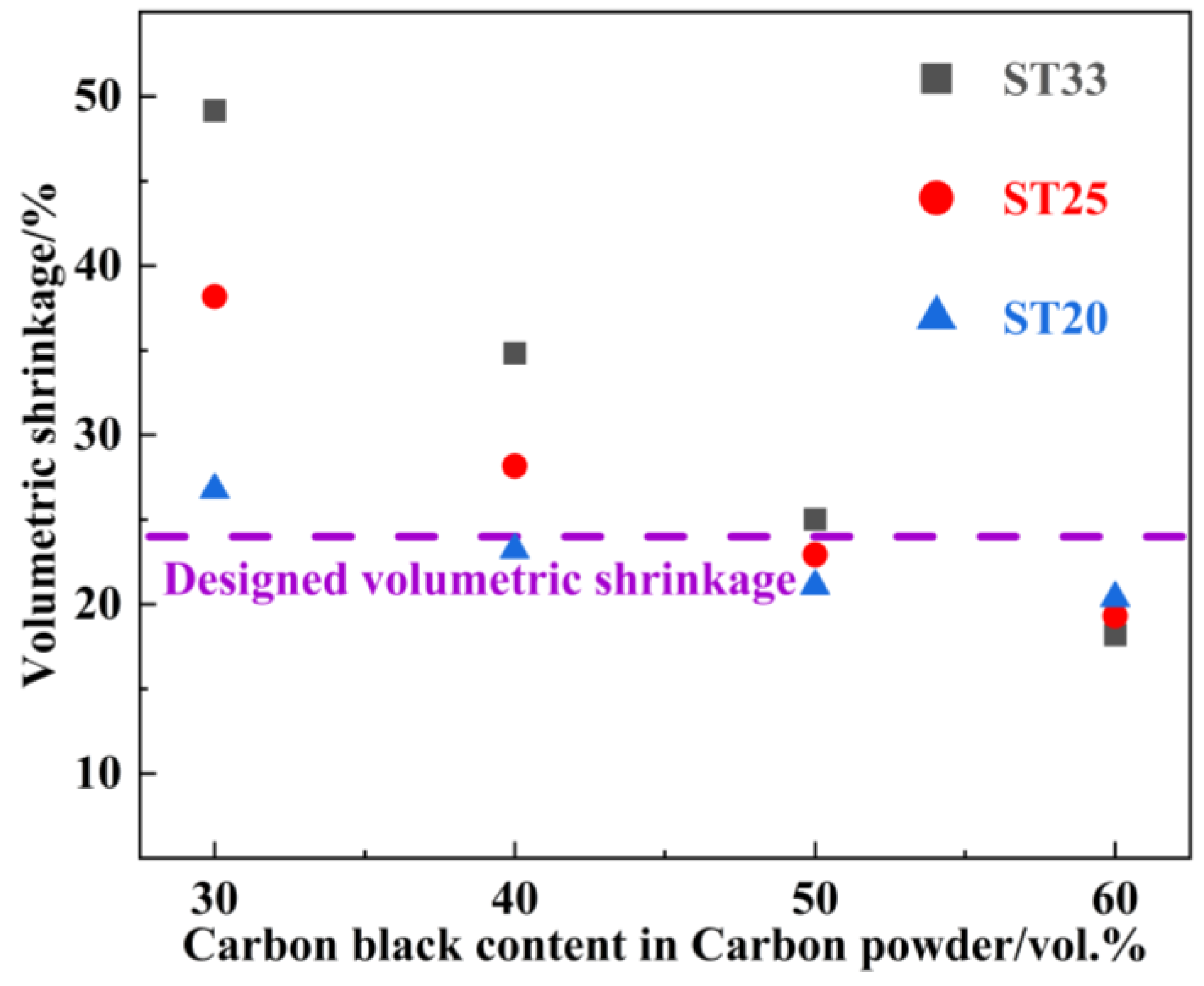
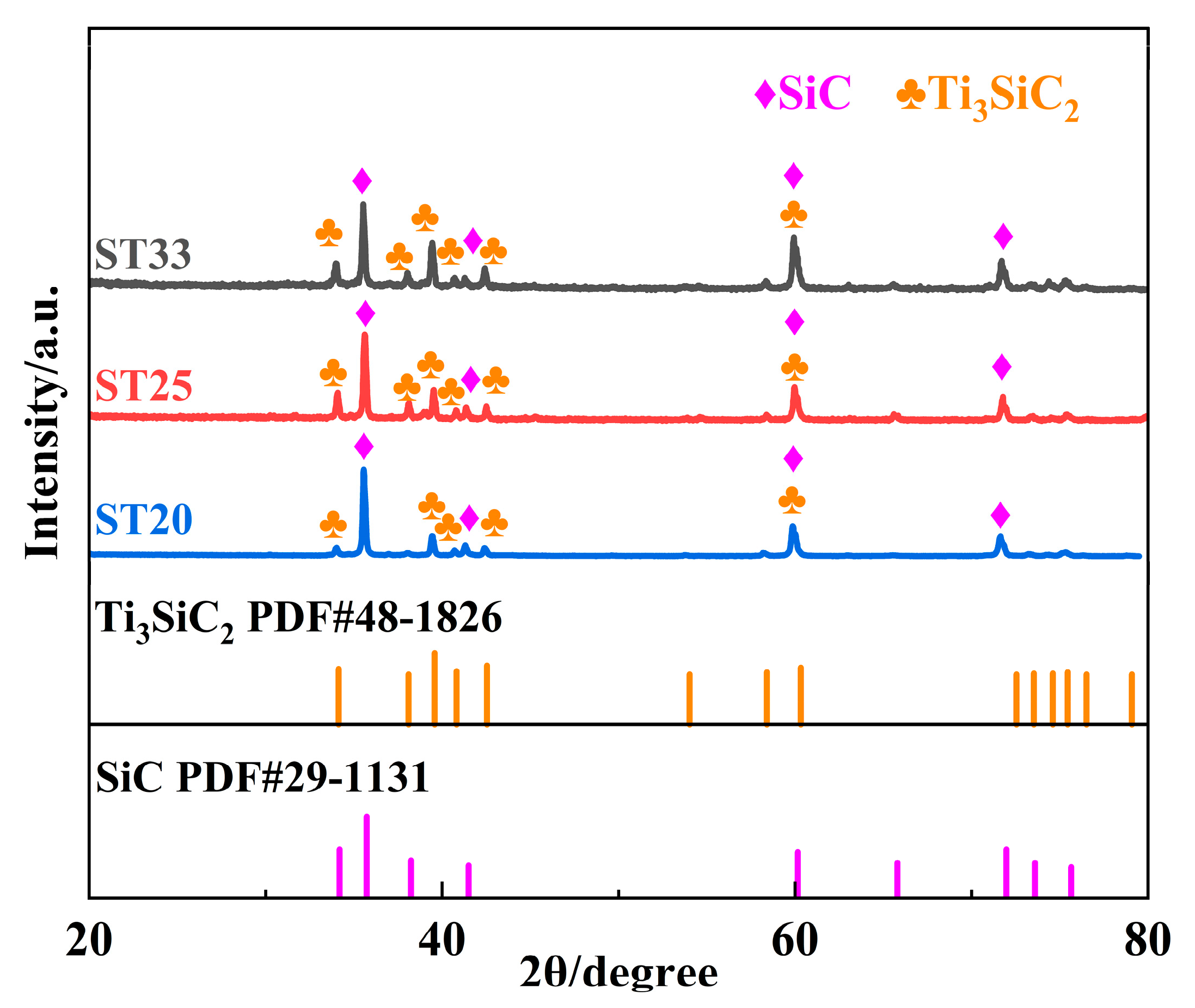
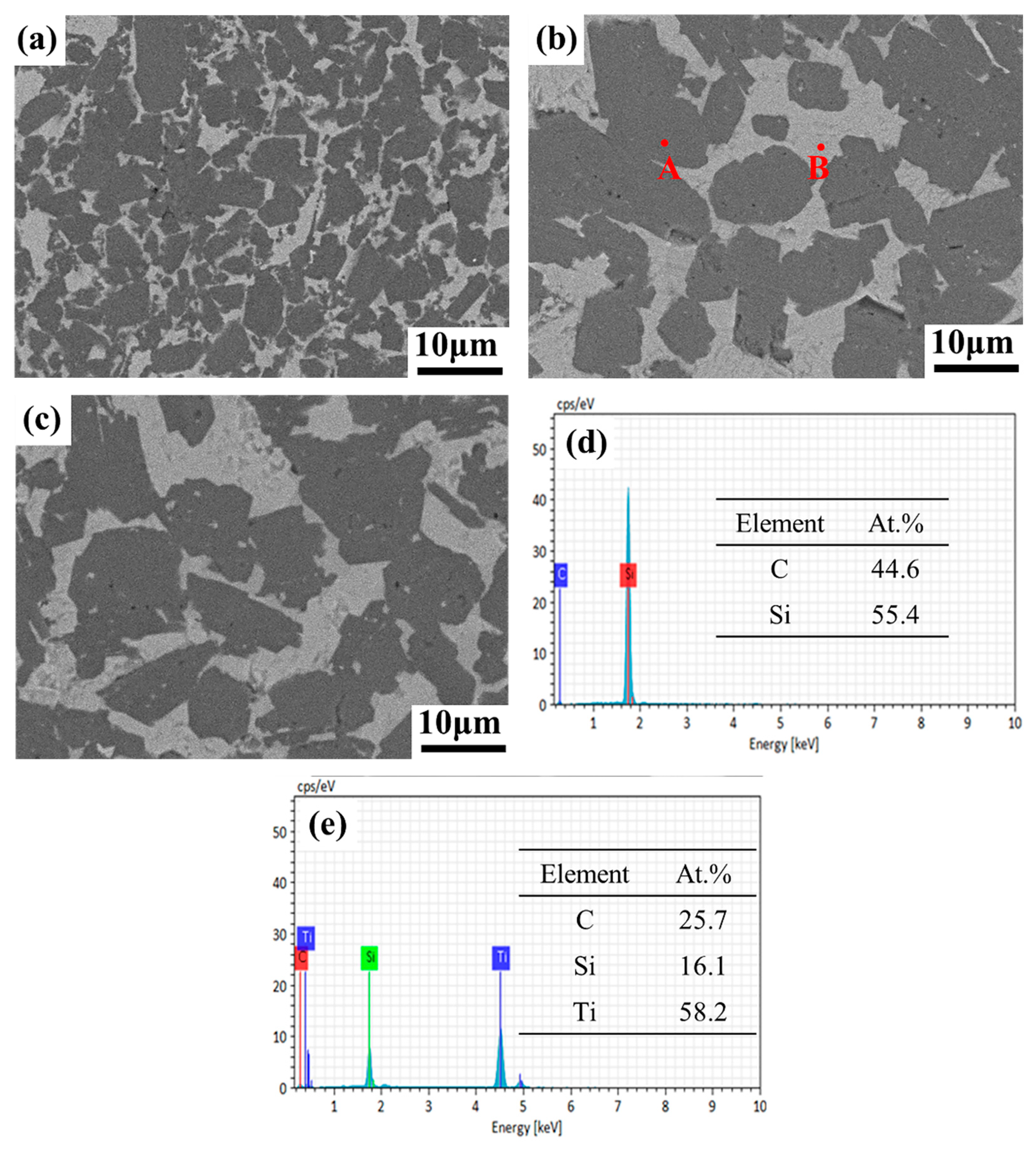
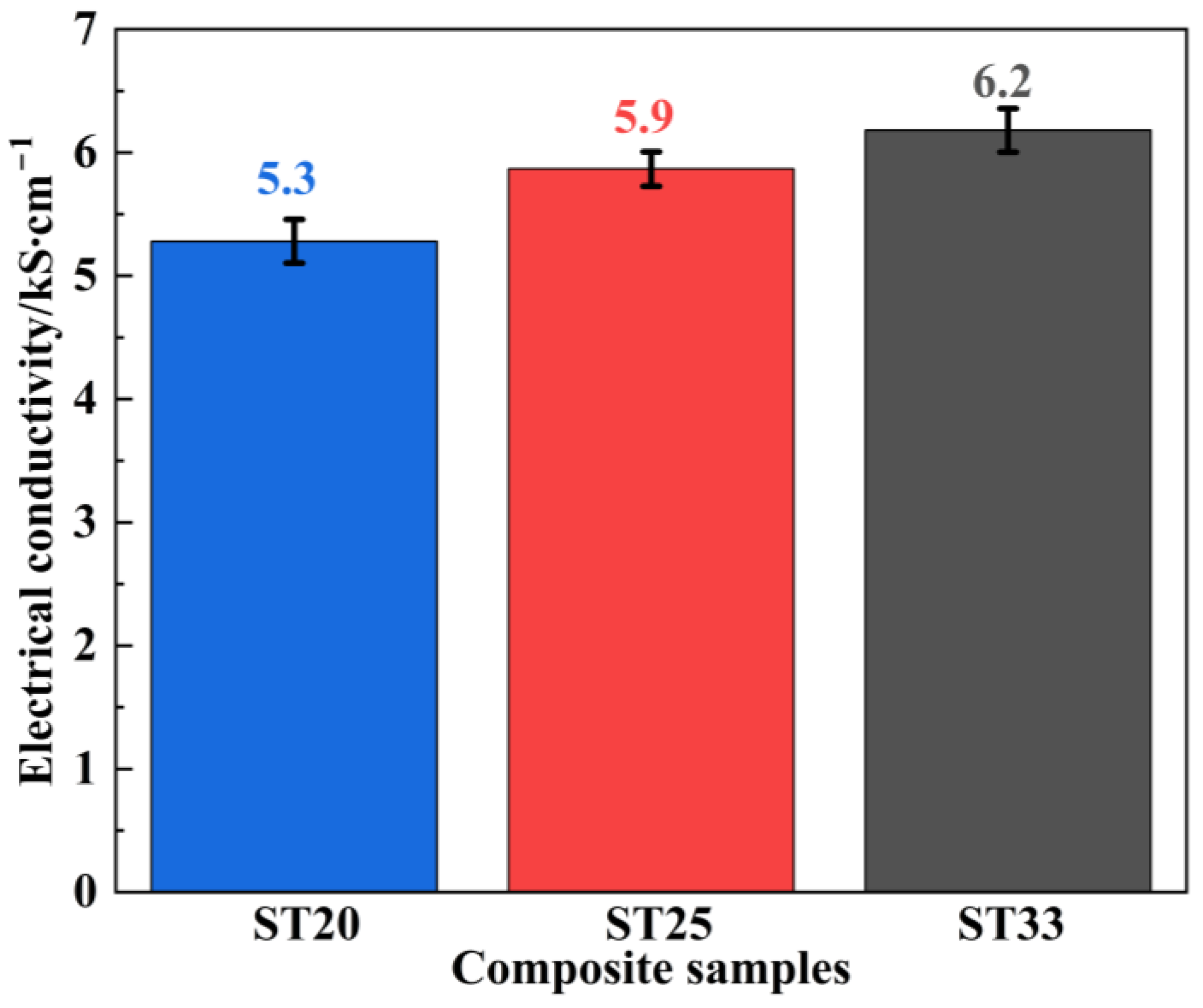


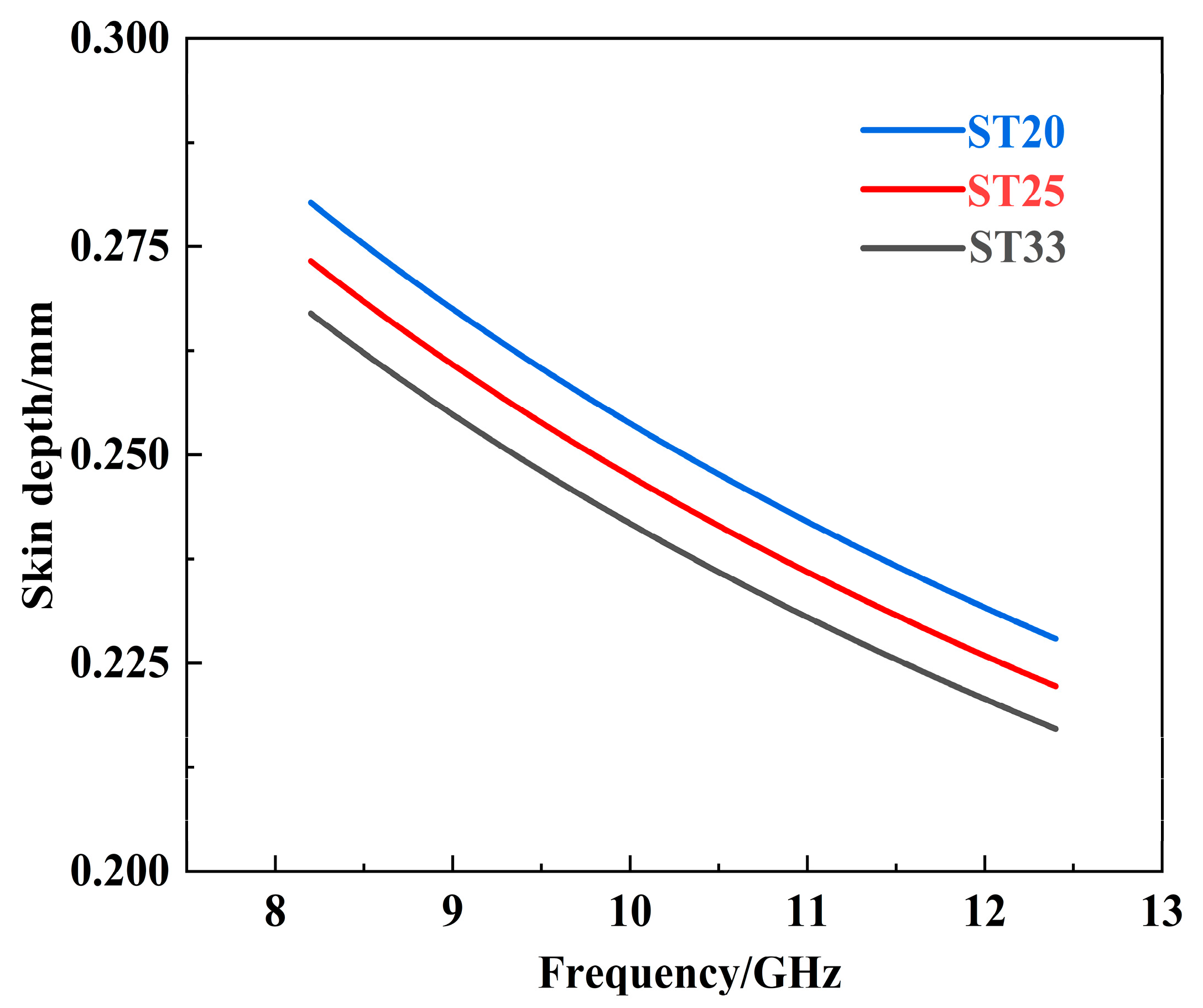
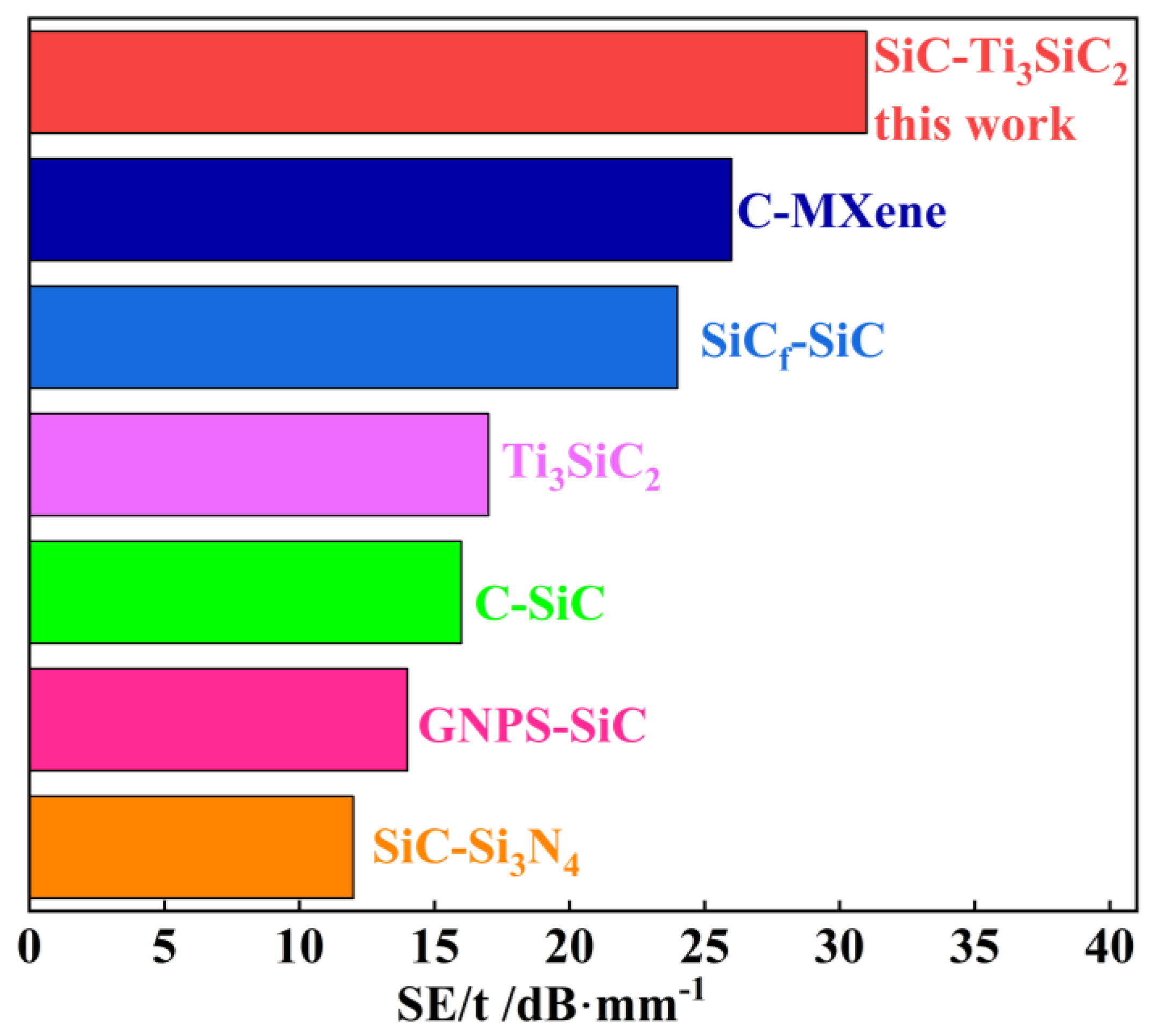
| ST Composites | Phase Compositions of Preforms/vol.% | Densities of Preforms/g·cm−3 | Porosity of Preforms/% | Ti3SiC2 Content of Composites/vol.% | |
|---|---|---|---|---|---|
| SiC | C | ||||
| ST20 | 60 | 40 | 1.73 | 34 | 20 |
| ST25 | 40 | 60 | 1.32 | 43 | 25 |
| ST33 | 20 | 80 | 1.04 | 51 | 33 |
| ST Composites | Slurry Compositions of the SiC-C Preforms for Composites/vol.% | |||
|---|---|---|---|---|
| Carbon Powder | SiC Powder | Ethylene Glycol | Phenolic Resin | |
| ST20 | 10.7 | 31.2 | 30.6 | 27.5 |
| ST25 | 19.1 | 19.3 | 34.6 | 27.0 |
| ST33 | 21.8 | 7.9 | 43.9 | 26.4 |
| ST Composites | The Theoretical Density/g·cm−3 | The Actual Density/g·cm−3 | ||
|---|---|---|---|---|
| Preforms | Composites | Preforms | Composites | |
| ST20 | 1.73 | 3.47 | 1.73 | 3.44 |
| ST25 | 1.32 | 3.54 | 1.33 | 3.51 |
| ST33 | 1.04 | 3.64 | 1.05 | 3.62 |
| ST Composites | Phase Compositions of the Preforms after the First Reaction/vol.% | ||
|---|---|---|---|
| SiC | TiC | TiSi2 | |
| ST20 | 80.5 | 12.1 | 7.4 |
| ST25 | 71.8 | 17.5 | 10.7 |
| ST33 | 63.7 | 22.5 | 13.8 |
| ST Composites | The Volume Fraction of Each Phase by Calculation/vol.% | The Volume Fraction of Each Phase by Pixel Statistics/vol.% | |||
|---|---|---|---|---|---|
| Ti3SiC2 | SiC | TiSi2 | Ti3SiC2 | SiC | |
| ST20 | 21.0 | 78.2 | 0.8 | 18.2 | 81.8 |
| ST25 | 25.7 | 73.4 | 0.9 | 25.0 | 75.0 |
| ST33 | 33.2 | 65.8 | 1.0 | 31.0 | 69.0 |
Disclaimer/Publisher’s Note: The statements, opinions and data contained in all publications are solely those of the individual author(s) and contributor(s) and not of MDPI and/or the editor(s). MDPI and/or the editor(s) disclaim responsibility for any injury to people or property resulting from any ideas, methods, instructions or products referred to in the content. |
© 2025 by the authors. Licensee MDPI, Basel, Switzerland. This article is an open access article distributed under the terms and conditions of the Creative Commons Attribution (CC BY) license (https://creativecommons.org/licenses/by/4.0/).
Share and Cite
Zhang, M.; Ma, Z.; Pan, X.; Li, Y.; Zhang, N.; Xue, J.; Yang, J.; Wang, B. Electromagnetic Interference Shielding Effectiveness of Pure SiC–Ti3SiC2 Composites Fabricated by Reactive Melt Infiltration. Materials 2025, 18, 157. https://doi.org/10.3390/ma18010157
Zhang M, Ma Z, Pan X, Li Y, Zhang N, Xue J, Yang J, Wang B. Electromagnetic Interference Shielding Effectiveness of Pure SiC–Ti3SiC2 Composites Fabricated by Reactive Melt Infiltration. Materials. 2025; 18(1):157. https://doi.org/10.3390/ma18010157
Chicago/Turabian StyleZhang, Mingjun, Zhijun Ma, Xueqin Pan, Yun Li, Nanlong Zhang, Jiaxiang Xue, Jianfeng Yang, and Bo Wang. 2025. "Electromagnetic Interference Shielding Effectiveness of Pure SiC–Ti3SiC2 Composites Fabricated by Reactive Melt Infiltration" Materials 18, no. 1: 157. https://doi.org/10.3390/ma18010157
APA StyleZhang, M., Ma, Z., Pan, X., Li, Y., Zhang, N., Xue, J., Yang, J., & Wang, B. (2025). Electromagnetic Interference Shielding Effectiveness of Pure SiC–Ti3SiC2 Composites Fabricated by Reactive Melt Infiltration. Materials, 18(1), 157. https://doi.org/10.3390/ma18010157






